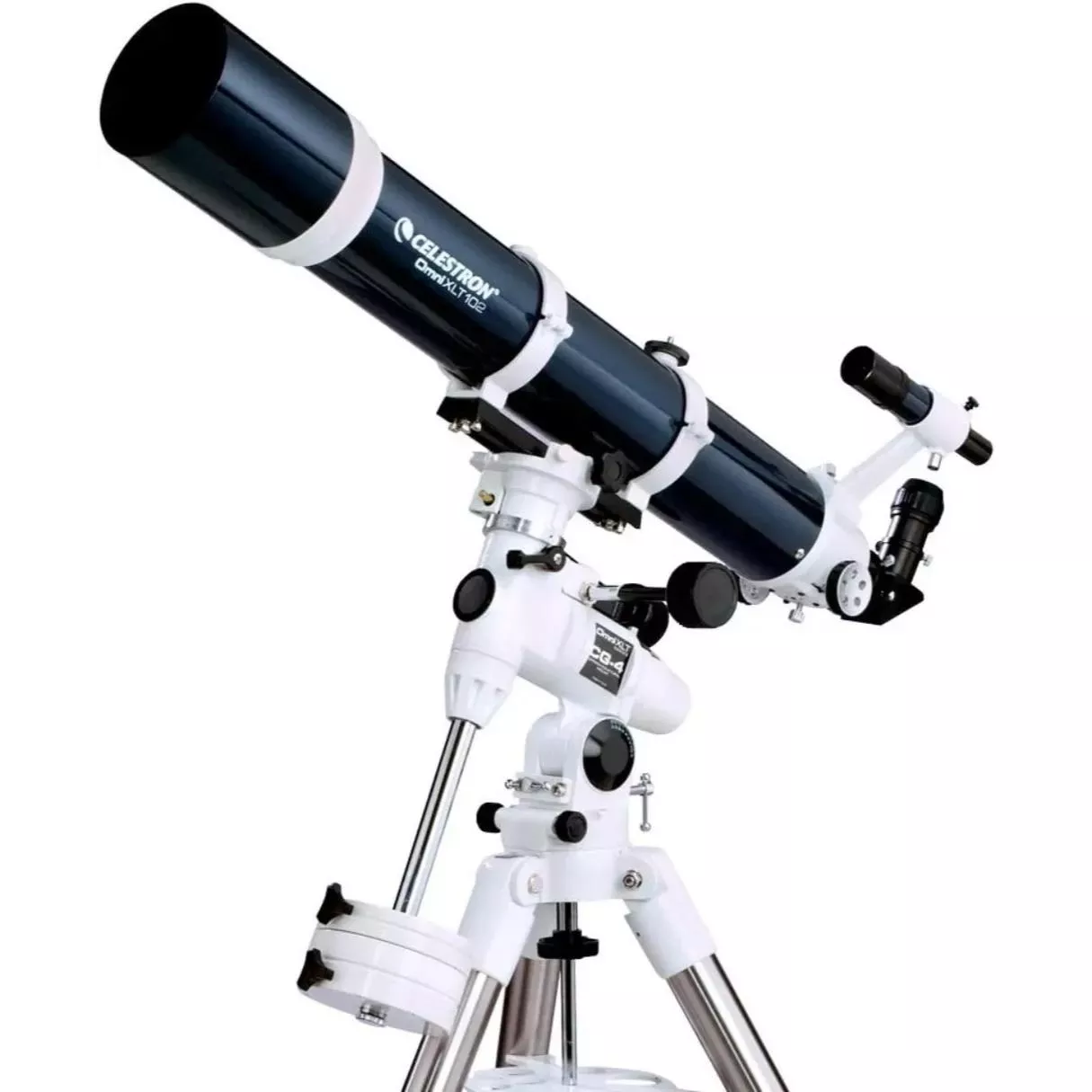Discover Celestial Wonders: XLT Coated Refractor Telescope

In the realm of astronomy, the right telescope can make all the difference in exploring the wonders of the universe. Among the various types of telescopes available, hand-figured refractor telescopes stand out for their exceptional optical performance and craftsmanship. Enhanced by XLT coatings, these telescopes provide enhanced light transmission and clarity, allowing stargazers to observe celestial objects in stunning detail. Coupled with a manual equatorial mount that offers precise tracking capabilities, the hand-figured refractor telescope is an ideal choice for both novice astronomers and seasoned enthusiasts alike. In this article, we will delve into the features, advantages, and optimal usage of hand-figured refractor telescopes, providing a comprehensive guide to understanding why they are a valuable addition to any astronomer’s toolkit.
## Introduction to Hand-Figured Refractor Telescopes
### What is a Hand-Figured Refractor Telescope?
So, you’ve decided to venture into the world of stargazing, and you’re considering a hand-figured refractor telescope. A mouthful, isn’t it? Basically, this marvel of optics utilizes glass lenses (not mirrors, mind you) to gather and bend light, bringing distant celestial wonders into sharp focus. The “hand-figured” part means that real humans, not robots, have painstakingly crafted and optimized the lenses—because nothing says “I love astronomy” quite like some artisanal optical engineering.
### Historical Background and Development
Let’s take a quick jaunt down memory lane. The refractor telescope has roots that stretch back to the 1600s, with the likes of Galileo and Kepler starring in the early chapters. Fast forward a couple of centuries, and people have started realizing that just because something is made by hand doesn’t mean it can’t be a scientific powerhouse. Today, hand-figured refractors combine traditional craftsmanship with modern materials and technologies, giving amateur astronomers the best of both worlds: vintage charm and stellar performance (pun intended).
## Understanding XLT Coatings and Their Benefits
### What are XLT Coatings?
Imagine coating your telescope’s lenses with a magical potion that helps them transmit more light. That’s pretty much what XLT coatings do! Developed to enhance the visual performance of telescopes, XLT stands for “Extra-Low Transmission.” These coatings are designed to reduce reflections and maximize the amount of light reaching your eager eyes, so you can see the rings of Saturn and not just a blurry ball of gas.
### Impact on Light Transmission and Image Quality
Light is the lifeblood of astronomy. With the XLT coatings, you’re looking at increased light transmission, improved contrast, and sharper images. It’s like trading in your old glasses for a brand-new pair with anti-glare—and who wouldn’t want clearer views of the cosmos? The clarity you gain allows for a deeper appreciation of celestial details that you’d otherwise miss, like the texture of a planet’s surface or the subtle hues of a nebula.
### Comparison with Other Coating Technologies
When it comes to telescope coatings, it’s a bit like comparing apples to oranges—each has its perks. XLT coatings are often pitted against standard multi-coatings or single coatings. While standard multi-coatings can get the job done, they don’t quite match the XLT’s prowess in both light transmission and durability. In the world of optics, XLT coatings are akin to the superhero of lens treatments. They might not wear capes, but they sure help you see the universe in all its glory!
## Features of the Manual EQ Mount
### Design and Construction
The manual equatorial mount (EQ mount for short) is the tried-and-true companion to your refractor telescope. Designed to track celestial objects as they glide across the night sky, an EQ mount is constructed to provide stability and precision. Made from sturdy metals and enhanced with friction clutches, it’s the workhorse of the astro world—think of it like the reliable friend who always drives when you’re out stargazing.
### Ease of Use and Adjustability
One of the best features of a manual EQ mount is its simplicity. No complicated electronics—just you, your skills, and a little bit of grit! Plus, these mounts are highly adjustable to suit your viewing angle, allowing you to tilt and turn your telescope with ease. You could say they adapt to your whims, so you can find that sweet spot to get the best views of celestial wonders without needing a degree in astrophysics!
### Benefits for Astrophotography
If you’re into capturing those epic shots of the night sky, the manual EQ mount is your best friend. Its tracking capabilities mean you can follow objects smoothly, reducing that pesky blur that comes from the Earth’s rotation (thanks, Earth!). With a steady mount, you can snag crisp images of everything from the moon’s craters to far-flung galaxies, making your Instagram followers both jealous and starstruck.
## Advantages of Using a Hand-Figured Telescope
### Optical Performance and Clarity
Let’s be honest: there’s nothing quite like the optical performance of a hand-figured refractor telescope. The level of care and craftsmanship that goes into creating these instruments translates to outstanding clarity and sharpness. You’ll feel like you’ve got a front-row seat to the universe, able to discern details that others might miss. It’s as if you’ve signed a cosmic VIP pass!
### Customization and Craftsmanship
With a hand-figured telescope, you’re not just buying a piece of equipment; you’re acquiring a work of art. Many models offer customizable options tailored to your viewing needs. Whether it’s tweaking the lens configuration or personalizing the finish, you can end up with a telescope that feels uniquely yours—a glowing testament to your passion for the stars!
### Portability and Ease of Transport
Lastly, portability can be a dealbreaker, especially if you’re planning to take your telescope on an adventure (road trips to dark-sky locations, anyone?). Hand-figured refractors are often lighter and more compact than their larger counterparts, making them easy to transport. So, pack up your telescope and hit the road—you might find the next best viewing spot is just a scenic drive away!# Hand-Figured Refractor Telescope with XLT Coatings and Manual EQ Mount
## Setup and Usage Tips for Optimal Performance
### Initial Setup and Alignment
Getting your hand-figured refractor telescope ready for its first cosmic adventure is a bit like assembling a jigsaw puzzle — but with fewer pieces and (hopefully) no missing ones! Start by securely attaching the telescope tube to the equatorial mount. Don’t forget to double-check that the mount is level; if it’s tilted, you might end up discovering stars that exist in an alternate universe.
Once everything is in place, align your telescope to the North Star (Polaris for those in the know) using the mount’s setting circles. A proper alignment will make tracking celestial objects smoother than your buddy at a karaoke night when they hit that high note.
### Best Practices for Observing
When the stars come out to play, make sure you’re ready to join the party! For the best views, choose a dark site away from city lights, because no one likes the “squint-and-hope” method of stargazing. Dress warmly (it gets chilly in space!), and give your telescope time to acclimate to the outside temperature — about 30 minutes should do the trick.
When you’re ready to start observing, keep a star chart handy (or an app, if you prefer your tech over paper). It can guide you through the cosmos like a GPS for the sky.
### Adjusting for Various Celestial Objects
One of the best parts about your hand-figured refractor is its versatility. To view planets, switch to a higher magnification eyepiece — think of it as putting on those fancy glasses that make everything crystal clear. For deep-sky objects like galaxies and nebulae, go lower; it’s less about seeing every little detail and more about capturing the grandeur of the universe.
Don’t forget to adjust the focus as you switch eyepieces! It’s like tuning a guitar for each song you decide to play.
## Comparing Hand-Figured Refractors to Other Telescope Types
### Refractors vs. Reflectors
Ah, the age-old debate: refractors vs. reflectors. Refractors use lenses and are famed for their crisp, sharp images. They’re like the well-polished gems of the telescope world. Reflectors, on the other hand, utilize mirrors and are typically larger for a lower price point. Think of them as the cheesy but fun alternative at a dance party — they may be a little rough around the edges, but they sure know how to gather a crowd!
### Pros and Cons of Different Telescope Designs
Every telescope design has its quirks. Refractors provide excellent color fidelity and require minimal maintenance, but they can be pricier for larger apertures. Reflectors, while offering a bigger bang for your buck, require regular cleaning and collimation (which sounds fancier than it is). And let’s not ignore compound telescopes — a middle ground that combines the best of both worlds but can get a bit heavy for stargazers who prefer a light pack.
### Choosing the Right Telescope for Your Needs
Choosing the right telescope is a bit like finding the right partner — you want one that fits your lifestyle. If you value portability and ease of use, the hand-figured refractor is your stellar match. If budget is your primary concern, reflectors might end up being your wingman. Consider your observing style, the types of objects you’re most excited about, and how often you plan to take your telescope on intergalactic adventures.
## Maintenance and Care for Longevity
### Cleaning and Storage Recommendations
Keeping your hand-figured refractor telescope clean is paramount — after all, you wouldn’t let grime ruin your pizza, would you? Use a soft brush or microfiber cloth to gently remove dust from the lenses. If your telescope gets really dirty, a few drops of lens cleaning solution on your cloth will do the trick.
When it’s time to store your beloved telescope, avoid leaving it in extreme heat or humidity; it won’t appreciate a sauna experience. Instead, keep it in a cool, dry place, preferably in a padded case that says, “I’m not just a telescope; I’m a work of art!”
### Regular Maintenance Practices
Set a schedule for regular checks — think of it as getting your telescope a spa day. Look over its mechanics, tighten any screws, and inspect the mount for smooth operation. It’s a good idea to check the focuser and ensure it’s as buttery smooth as your favorite ice cream.
### Common Issues and Troubleshooting
Sometimes, your telescope may throw a celestial tantrum. If images appear blurry, ensure the lenses are clean and check if the focus is properly adjusted. If you find that the mount is stiff, a little lubrication should get it back to its graceful self. If it feels like you’re facing an intergalactic conspiracy, don’t hesitate to dive into the manual or join an astronomy forum — there are plenty of stargazers ready to help you out.
## Conclusion: Why Choose a Hand-Figured Refractor Telescope
### Summary of Key Points
In summary, the hand-figured refractor telescope with XLT coatings offers sharp images, minimal maintenance, and the joy of bringing distant celestial wonders into sharper focus. With a manual EQ mount, it gives you the added benefit of tracking objects without fancy tech getting in the way.
### Final Thoughts and Recommendations
If you’re looking for a telescope that’s user-friendly and visually stunning, the hand-figured refractor is your ticket to cosmic exploration. Whether you’re a newbie or a seasoned star-watcher, this beauty will make your stargazing experience one for the books. So dust off your star charts, grab some warm drinks, and get ready to dance among the stars — your telescope is ready to take you on the journey of a lifetime!In conclusion, hand-figured refractor telescopes equipped with XLT coatings and manual equatorial mounts offer a unique combination of quality, performance, and ease of use that appeals to astronomers of all skill levels. With their superior optical clarity and precise tracking capabilities, these telescopes make stargazing an enriching and enjoyable experience. Whether you’re observing planets, galaxies, or nebulae, investing in a hand-figured refractor telescope can enhance your astronomical adventures and deepen your appreciation for the night sky. As you embark on your journey through the cosmos, remember that the right telescope can open up a universe of possibilities.









Leave a comment